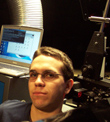|
|
This topic comprises 4 pages: 1 2 3 4
|
|
Author
|
Topic: Scanning film @4K for archiving, reissuing, and ultimate home theater
|
Mark J. Marshall
Film God

Posts: 3188
From: New Castle, DE, USA
Registered: Aug 2002
|
 posted 04-19-2004 08:07 PM
posted 04-19-2004 08:07 PM



Interesting article over at the New York Times website.
Original Story Here Text Below....
600 Macs, 4,000 Lines, One Giant Leap for DVD's
By FRED KAPLAN
Published: April 18, 2004
On the second floor of an unassuming office building on the edge of Burbank, John Lowry is forging what might be the future of the DVD — and, with it, the way that classic films will be stored, preserved, telecast and watched.
Mr. Lowry, who has worked for decades at enhancing video imagery, is responsible for some of the best-looking DVD restorations in recent years, including transfers of "Casablanca," "Singin' in the Rain" and "Once Upon a Time in the West."
Since last November, he has been immersed in a project that promises to advance the state of the art — and that has been kept secret, even among most industry insiders, until now.
What he is doing will make a DVD look nearly as sharp and detailed as a 35-millimeter film print. It will produce images with six times the resolution of today's high-definition television sets. In video quality, it could turn home theater into a true rival of the neighborhood cineplex.
Walk into the suites of Lowry Digital, the company that Mr. Lowry started six years ago, and the first sight that strikes you is the computer bank — rack after rack of Macintosh G5 computers, 600 of them, holding a combined memory of 2,400 gigabytes.
Beyond this room is a super-sanitized, temperature-controlled chamber. Inside, a technician wearing a white smock and cap monitors a pair of machines called the Imager XE-Advanced, made by the Imagica Corp.
The Imagica machines are ultra-sophisticated digital film-scanners. They are loaded with reels from the original negative of the 1967 James Bond movie "You Only Live Twice."
The spools advance slowly, one frame every four seconds, which is how long it takes the Imagica to scan across a frame 4,000 times — a process known as 4K scanning.
During the scan, the machine creates a digital replica of the frame, consisting of 4,000 horizontal lines of data. A cable then transmits this data to a hard-drive server in an adjoining room.
To put the magnitude of 4,000 lines in perspective, a television displays broadcast signals as 480 lines. High-definition televisions have up to 1,080 lines. (The greater number of lines, the more detailed the image — the more closely it resembles a seamless, lifelike picture.) Impressive as HDTV looks, 35-millimeter film has far more color and detail. Engineers calculate that 4,000 lines of data would be needed to reproduce all the visual information in a frame of film — exactly as many lines as the Imagica delivers.
So, if it scans an original camera negative, as it's doing with "You Only Live Twice," it creates a data file that's a virtual duplicate of the negative.
By contrast, most DVD's these days — good as many look — begin with a compromise: they're scanned at just 1,080 lines, at most 2,000 (sometimes as few as 480), and the source is almost always not the original negative but a copy. When you start with a copy, Mr. Lowry said, "you're immediately losing lots of details. Colors are less pure, too."
In other words, a DVD that's scanned at 4K from an original negative should look better than the best DVD's today. That's the theory, anyway.
MGM has hired Lowry Digital to make 4K digital masters of nine James Bond films, including all of those starring Sean Connery. I have watched scenes from a high-definition transfer of these masters on monitors at Lowry Digital. I've also seen a DVD, which Mr. Lowry gave me, on my TV set at home.
The scenes look as brilliant as anything I've seen on a video disc — and better than any video of a color movie that was shot 35 to 40 years ago. Colors are saturated and natural. Gardens have dozens of shades of green. Flesh tones are uncannily lifelike. Shadows look like shadows, not gray blots. Motions are smooth, not jumpy.
MGM executives decline to say when they'll be releasing these Bond DVD's — or anything else about the project, except to confirm that it exists. The new discs won't be out until next year at least — perhaps in part to avoid angering consumers who bought the 20 Bond films in three boxed sets that MGM put out just last year. Those discs (which Mr. Lowry had nothing to do with) tend to look grainy, blotched and flat.
They were made with the materials at hand — faded film stock and high-definition (sometimes standard-definition) scanners. Studios frequently use 4K scanners for computer animation and special effects, but few have even considered 4K-scanning of entire movies for DVD. It's an expensive operation. An Imagica scanner costs about $300,000. The G5 computers cost $3,000 apiece. The software, servers and so forth aren't cheap either. All told, mastering a DVD in 4K costs two to four times as much as doing it the usual ways.
The attraction of going this route is that it produces not just better-looking DVD's for now but a foundation for formats of the future.
In its current format, an image on a DVD consists of about 500 lines — no more than a DVD player can "read" or a regular TV set can display. Even a 4K master has to be reprocessed to fit the DVD format. (It will still look better, just as a photo taken by a Nikon looks better than one taken by a disposable camera, even on newsprint.)
Some time in the next decade, though, DVD's will probably be supplanted by high-definition DVD's. High-definition TV may evolve into ultra-HDTV. (Engineers in Japan have built prototype discs and monitors that display 4,000 lines.)
A hard-drive master that contains a 4K scan could serve the same function as a film negative — a source of copies, for whatever medium. Unlike film, it won't fade; and as video technology improves — as its resolution becomes higher and higher — there will be no need to make new masters; 4K is high enough to accommodate the changes.
"We're making an archive — for DVD, film, digital cinema, HDTV, TV, whatever — that will last the next two or three generations of technology," Mr. Lowry said.
Thirty-five years ago, Mr. Lowry, who is now 71, patented a method of cleaning up NASA's live televised transmissions from the moon. Six years ago, as the DVD took off, he set up Lowry Digital — then a two-man R & D shop — to apply his techniques to digital restoration.
He hired a photographer to make a short 35-millimeter film clip of some children playing soccer on a lakeshore. He paid a local lab to transfer the film to digital video, using a 4K scanner. The picture was clear, sharp, detailed. He then processed the images with his film-restoration software, which he'd programmed onto some Macintosh G4 computers. (The effort took months, as the faster G5's weren't out yet.) The processed picture was clearer, sharper and more detailed still. He could see every divot on the turf. What had once looked like a smudge in the background was now recognizable as a boat on the lake.
In January 2000, some executives from Warner Brothers saw his demo. They were so impressed, they faxed him an order the same day to restore the masters for three DVD's: "Gone With the Wind," "Now Voyager" and "North by Northwest." With the advance money, he bought the computers he needed to do the job.
Since then, he has bought hundreds of computers, hired a staff of 30 and worked on 80 DVD's — including the long-awaited DVD of "Star Wars" — erasing wear, tears, dirt, scratches and other ravages of age. (In the early days, he sometimes erased too much. By his own admission, his restoration of "Citizen Kane" is too clean; the natural grain of film is gone; it looks like a video. He later figured out how to fix flaws while preserving grain.)
Many restoration specialists do this sort of work manually, often frame by frame. Mr. Lowry may be the first to do digital restoration while the images are still in a digital format — a bunch of 0's and 1's inside a computer — before they're transferred to video.
Not long ago, MGM sent a camera crew to interview him about his restoration techniques for a "special feature" to be included on the Bond DVD's. The question now is how long it will take MGM to release these DVD's and how long it will take other studios and digital-mastering houses to catch on — in short, how long it will take for the future to begin.
| IP: Logged
|
|
|
|
|
|
|
|
|
|
|
|
|
|
Daryl C. W. O'Shea
Film God

Posts: 3977
From: Midland Ontario Canada (where Panavision & IMAX lenses come from)
Registered: Jun 2002
|
 posted 04-19-2004 08:57 PM
posted 04-19-2004 08:57 PM





Although not very descriptive, it's sort of right. Each line is scanned laterally, across the frame. Of course 4K scanning denotes 4096 horizontal pixels, not lines.
quote: IMAGICA INTRODUCES IMAGER XE – ADVANCED – DIGITAL FILM SCANNER
September 08, 2003
IMAGICA INTRODUCES IMAGER XE – ADVANCED – DIGITAL FILM SCANNER
Newest scanner offers faster speed and quality. Perfect for digital intermediate process
September 8th, 2003...IMAGICA Corp., Tokyo, Japan, the leader in digital film scanners,
introduced today a new digital film scanner, the IMAGER XE - ADVANCED. IMAGER XE -
ADVANCED is the newest generation in IMAGICA’s product line of digital film scanners.
The IMAGER XE -ADVANCED, designed as a true scanner, scans 4096 pixels across a 35mm
Academy frame and provides Cineon format with full RGB color space(14bit A/D), as well
as consistent color and density, frame after frame.
The IMAGER XE -ADVANCED scans 2seconds/frame for 2K and 4seconds/frame for 4K
resolution, significantly faster from the current IMAGER XE®. Differences from the
current generation IMAGER XE® include a new 5K- camera system, new internal processing
system, and the network is Gigabit-Ether. In addition to 35mm, the IMAGER XE -ADVANCED
also supports 16mm and Super 16. In addition, an 8K-camera system is available as an
option. The 4K image is sub-sampled from 8K.
There is an upgrade path for current IMAGER XE® customers who would like to upgrade to
the IMAGER XE -ADVANCED.
IMAGICA is continually advancing its scanner technology to meet the rigorous demands
required by post-production facilities around the globe, and provides an upgrade path
to preserve the investment by these facilities. The new IMAGER XE -ADVANCED is the
latest example of IMAGICA’s commitment to the marketplace Renowned for its customer
service and superior technology, IMAGICA is indeed the market leader in the post-
production community for digital film scanners.
Mr. Makoto Tsukada, Director of the Engineering Solutions Division at IMAGICA, says,
“There are many facilities that require both speed and quality, and don’t want to
compromised with scanners of lesser quality and performance from other manufacturers.
These facilities also want the peace of mind knowing that they’re investing in
technology provided by a well-established company who will continually improve its
scanner products far into the future. IMAGICA has been providing digital film scanners
to this market for many years. We’re experts in this field, not newcomers, and we
provide unparalleled support and service, which is why facilities continually invest
in our scanners to meet their scanning needs”.
IMAGICA scanners have been used on such films as Lord of the Rings: Fellowship of
the Ring and The Two Towers, Spiderman, Stuart Little 2, Harry Potter and the
Sorcerer's Stone, Cats & Dogs, Enemy at the Gates, The Planet of the Apes, Scary
Movie 2, Cast Away, and many others.For further information, contact:
U.S., Canada and South America Sales
IMAGICA Corp. of America
5301 Beethoven Street, Suite 109,
Los Angeles, CA 90066, USA
tel: 310-306-4180 fax: 310-306-2334
e-mail: sales@imagica-la.com
Europe, Asia and Oceania Sales
IMAGICA Corp.
2-14-1, Higashi Gotanda,
Shinagawa-ku, Tokyo, 141-0022, Japan
tel: +81-3-3280-1119 fax: +81-3-3280-7527
e-mail: products@lab.imagica.co.jp
###
All product names are trademarks of their respective companies.
September 8, 2003 11:29 AM
| IP: Logged
|
|
|
|
|
|
John Pytlak
Film God

Posts: 9987
From: Rochester, NY 14650-1922
Registered: Jan 2000
|
 posted 04-19-2004 10:44 PM
posted 04-19-2004 10:44 PM





quote:
Electronic noise, shimmering and even some hints of pixellation were popping up on screen. That stuff wouldn't show up so easy if done at 4K.
Pretty much the findings of image scientist Dr. Roger Morton and his team, as reported in several recent SMPTE papers:
Roger Morton on Film Scanning
quote:
Digital film mastering is now typically done at 2K resolution, however the technology for working at 4K resolution is available, and Morton says it is expected to become a more practical and affordable tool in the foreseeable future.
SMPTE Paper May 2003
quote:
An Introduction to Aliasing and Sharpening in Digital Motion Picture Systems
By Roger R. A. Morton, Michelle A. Maurer, and Christopher L. DuMont
Abstract
Many interacting factors affect image quality. This paper discusses the measurement of some crucial factors and reviews their interactions. Specifically, how pixel count can interact with the image-quality factors of limiting resolution, aliasing ratio, and shape of frequency response. A new tool designed for onscreen image-quality measurements for both film and electronic projectors is described, and actual examples of aliasing artifacts are shown in still images from digital motion picture systems. It is then illustrated how aliasing artifacts can arise, although Nyquist sampling requirements are satisfied. Finally, some of the interactions between limiting resolution and frequency response shape for still and moving images are explained.
SMPTE Paper July 2003
quote:
Relationships between Pixel Count, Aliasing, and Limiting Resolution in Digital Motion Picture Systems
By Roger R. A. Morton, Christopher L. DuMont, and Michelle A. Maurer
Abstract
This paper analyzes how pixel count affects one type of aliasing artifact and image rendition near limiting resolution. A previous paper1 showed that aliasing artifacts take many forms. This paper focuses on the aliasing artifact identified in the ISO 12233 standard and identified as Type A aliasing in the prior paper. A relationship termed “Type A aliasing equation” is presented, which predicts aliasing as measured by the ISO 12233 standard. It is then demonstrated that this equation predicts the best unreconstructed aliasing performance for digital motion picture systems and subsystems, thereby defining one characteristic of an ideal system. The predicted result is then compared by the Type A aliasing equation and the measured aliasing performance of 20 different digital motion picture systems and subsystems. It is also shown that the Type A aliasing equation is superior to the classical Nyquist theory as a predictor of aliasing performance of digital motion picture systems. Finally, the equation is used to compute the minimum number of pixels required for a given aliasing level and limiting resolution, and data is presented to determine the pixel count required to render a given limiting resolution.
[ 04-20-2004, 07:43 AM: Message edited by: John Pytlak ]
| IP: Logged
|
|
|
|
|
|
|
|
Leo Enticknap
Film God

Posts: 7474
From: Loma Linda, CA
Registered: Jul 2000
|
 posted 04-20-2004 01:55 AM
posted 04-20-2004 01:55 AM





quote:
Many restoration specialists do this sort of work manually, often frame by frame.
Because in many scenarios, automating the process of examining and correcting defects using software produces flawed results; and I certainly don't know of any computer-based system which can carry out an automated technical comparison of multiple source elements. If you're starting with a camera negative in relatively good condition (as with the You Only Live Twice example), then technical selection is a no-brainer. And if there is only one form of consistent damage (e.g. dye fading), then the restoration process can be automated efficiently with very good results. But what happens when you're faced with 20 source elements of the same material, which may be a mix of intermediates, release prints, separate titles and opticals and all sorts? And furthermore, what if the element you select for duping has a combination of many different kinds of damage in various sections and to differing levels of severity? In that scenario there's no substitute for an archivist making decisions using his or her eyes. As Martin Koerber pointed out in a 'restoration of' extra on the Metropolis DVD, high-resolution digital image manipulation has a huge amount to offer in terms of implementing restoration decisions, but in most cases, only when it's under the control of an experienced operator. Just scanning the film and telling the computer to get on with it will often yield inferior results.
quote:
Mr. Lowry may be the first to do digital restoration while the images are still in a digital format — a bunch of 0's and 1's inside a computer — before they're transferred to video.
Whether he was the first or not, it is increasingly becoming a routine tool, even for smaller archives. For example, one of the regional archives in Britain has recently bought the Diamant software, which runs on a normal high-end PC. They send films to a facilities house for scanning. The data comes back on some sort of tape streamer and is then worked on in 10-minute segments before being outputted back to another tape and sent back to the lab for output on the required format. This can be anything from 35mm to VHS. Both the original, unrestored 'as scanned' data tapes and the restored data are archived as master elements, along with the film originals.
So it seems to me that the only significantly new thing Mr. Lowry is doing is to scan the 35mm originals at far higher resolution than he'll ever need for any sort of retail video format, unless we get to the stage of having 20ft screens in our living rooms. Personally I'd say he was throwing money down the pan, because the cost per foot of scanning this stuff is likely to drop massively in the next few years. Surely it makes far more sense to preserve the originals in the ideal atmospheric conditions (where they would survive without any significant further decomposition for centuries), and scan them to the required and most cost-effective resolution as and when you need them in digital form.
| IP: Logged
|
|
|
|
All times are Central (GMT -6:00)
|
This topic comprises 4 pages: 1 2 3 4
|
Powered by Infopop Corporation
UBB.classicTM
6.3.1.2
The Film-Tech Forums are designed for various members related to the cinema industry to express their opinions, viewpoints and testimonials on various products, services and events based upon speculation, personal knowledge and factual information through use, therefore all views represented here allow no liability upon the publishers of this web site and the owners of said views assume no liability for any ill will resulting from these postings. The posts made here are for educational as well as entertainment purposes and as such anyone viewing this portion of the website must accept these views as statements of the author of that opinion
and agrees to release the authors from any and all liability.
|

 Home
Home
 Products
Products
 Store
Store
 Forum
Forum
 Warehouse
Warehouse
 Contact Us
Contact Us




 Printer-friendly view of this topic
Printer-friendly view of this topic







![[Smile]](smile.gif)


![[Roll Eyes]](rolleyes.gif)


![[Shrug]](graemlins/shrug.gif)


![[Confused]](confused.gif) huh?
huh? 



